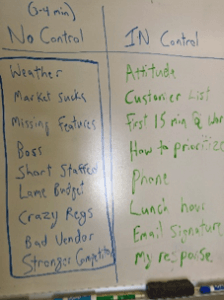Late Tuesday afternoon we were meeting in our small conference room to figure out what was going wrong with a client-sensitive project and how to fix it. Something was getting in the way of us reaching our potential . . . we were missing the opportunity to delight our clients. We seemed to be drifting a bit.
I had every confidence in the team and the manager I was meeting with.
We reviewed the facts, what we were seeing. No disagreement there. Then I asked her for her thoughts. She thoughtfully walked me through the mire that was bogging the team down. There were some sticky challenges. “Ok, but what should we do about it?” I asked. That’s when I started getting frustrated.
I knew she had the answer, but she was stuck in a quicksand of circumstances and needed a bit of creativity to escape. She was fighting the muck she was in rather than thinking about what else she could do. She needed to reframe the issue in a more solution friendly way. Though she was in quicksand, she needed to remind herself how she was in control.
“Something was getting in the way of us reaching our potential”
In a recent Freakonomics interview, How to Be More Productive, Pulitzer prize winning, The New York Times author Charles Duhigg highlighted research that revealed how critical an internal locus of control is to success. He said “. . . everyone either has an internal locus of control, which means that they believe that they control their own fate or an external locus of control, which means that they think things just happen to them and they’re powerless.” He explained how reframing our thinking can begin to shift our locus of control back to center where we can think and act most effectively.
Here’s a simple exercise that can help unstick your focus from all the stuff that will make you lose to the only way you can win. I learned this from Dr. Henry Cloud’s book, Boundaries for Leaders.
On paper or a white board, make two columns. Label the first one “NO control.” Spend three to four minutes listing all of the element you’re stuck with, the things you can’t change or deal with. Get all the annoying, frustrating, “if only . . .” items listed that you can think of. Draw a box around the list. With it contained, turn your focus to the second column. Label it “IN Control.” List everything that you CAN control, small and large. Simple things like your attitude, what you listen to on the way home from work or how you spend the first 15 minutes at your desk. The list may be short or filled with a lot of wimpy looking control points. It’s advanced common sense–that this is where your power is. Focusing on anything else is a waste of time, unless you want to remain stuck. It is often the case that your competition has the same list of NO Control items. You’re in the same mess. That’s great! Leave them to mind the loser list, while you work out how to get the heck out of here using the Controls you do have.
